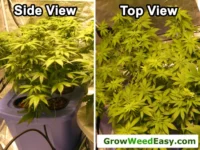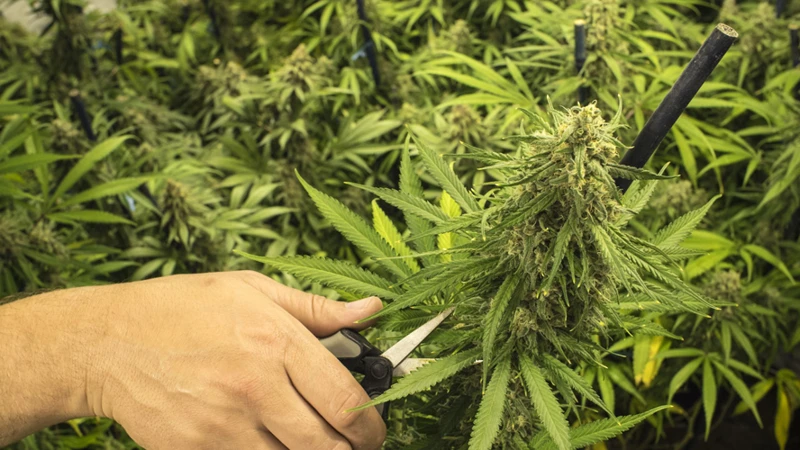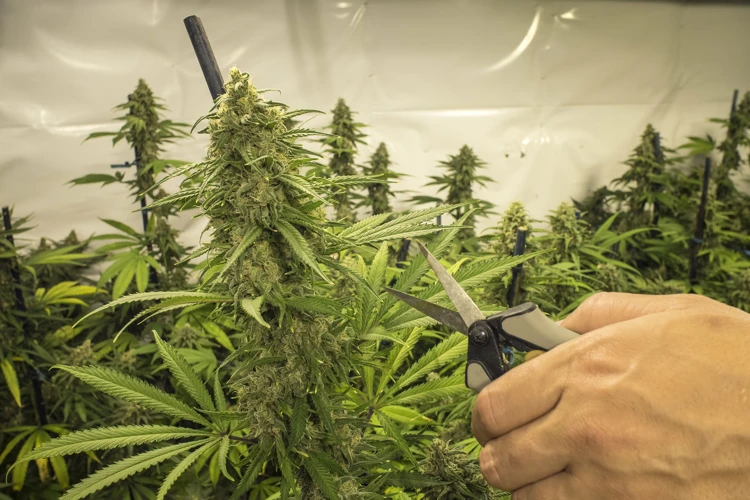
Maximizing Cannabis Yield and Potency Through Harvesting Techniques
Introduction
Contents
The moment of cannabis harvest is pivotal when it comes to achieving optimal potency and yield. Growers must employ careful techniques to ensure their plants are harvested at the right time, handled carefully, and cured properly. In this guide, we will explore the essential harvesting techniques of maximizing cannabis yield and potency. From determining the right time to harvest to the tools used in the process, we’ll cover everything a grower needs to know for a successful harvest.
Why Harvesting Techniques Matter
The precise harvesting techniques can have a huge impact on the yield and potency of your cannabis plants. Here are a few reasons why the techniques used during harvest matter:
- Timing is critical: Harvesting too soon can result in a lower yield and less potent buds. On the other hand, waiting too long to harvest can lead to THC degradation and less flavorful buds.
- Harvesting tools: Using the wrong harvesting tools or techniques can damage the plants and decrease yield. Sharp scissors or pruning shears should be used to minimize damage to the buds.
- Flushing: Flushing plants prior to harvest can remove any excess nutrients and improve the taste and aroma of the buds.
- Curing: Proper curing and storage techniques can increase potency and prevent mold or mildew growth.
- Drying: Over-drying or under-drying buds can cause them to lose potency and flavor.
All of these factors should be carefully considered and planned for in order to maximize yield and potency. By harvesting properly and utilizing the right techniques, you can produce the highest-quality cannabis possible.
Harvesting Techniques for Maximized Cannabis Yield
When it comes to growing cannabis, achieving the highest possible yield is the ultimate goal for most cultivators. However, harvesting cannabis plants can be a tricky process that requires careful consideration and attention to detail. With the right techniques, however, it is possible to maximize the yield of your cannabis crop. In this section, we will explore some effective harvesting techniques for achieving the biggest possible yield from your cannabis plants. From determining the right time to harvest, to using the right tools and techniques, we will cover everything you need to know to maximize your cannabis yield. So, let’s dive in!
Determining the Right Time to Harvest
Determining the perfect time to harvest cannabis plants is crucial in yielding the highest quality and quantity of buds. The right time to harvest depends largely on the strains, but there are some general guidelines that can be followed to ensure that your plants are harvested at the optimal time.
Visual Inspection Method
One of the easiest ways to determine the right time to harvest is through a visual inspection of the plant’s trichomes. Trichomes are tiny mushroom-shaped crystals that cover the surface of the buds and leaves. These crystals contain the plant’s cannabinoids, which are responsible for the effects of cannabis. As the plant matures, the color of the trichomes changes from clear to cloudy, and finally to amber.
To check the trichomes, you will need a magnifying tool like a jeweler’s loupe or a microscope with at least 60-100x magnification. Gently remove a small piece of a bud and place it on a flat surface. Hold the magnifying tool up to the bud and inspect the color of the trichomes. If most of the trichomes are still clear, the plant is not ready for harvest. If most of the trichomes are cloudy, it’s the perfect time to harvest for a more cerebral high. For a more sedative effect, wait until many of the trichomes have turned amber.
Weighing the Pros and Cons
Another approach to knowing when to harvest is to weigh the benefits of different stages of harvest. An early harvest produces buds that have a more cerebral high, while a late harvest will produce buds that are more sedative. Early harvesting also results in less yield, while late harvesting can cause the buds to become too heavy and potentially damage the plant. Too late harvesting can lead to a decrease in THC content and an increase in CBD content, which can compromise the potency of your buds.
Environmental Factors
Environmental factors such as temperature and humidity can also impact the timing of when to harvest cannabis plants. High temperatures can cause the buds to dry out and lose potency while the presence of excess moisture can lead to mold and mildew growth.
It is crucial to determine the right time to harvest cannabis plants to produce the best yields and potency. Using the visual inspection method to check the trichomes, weighing the pros and cons of different stages of harvest, and monitoring environmental factors are all helpful approaches to help you determine the perfect time to harvest your cannabis plants.
Types of Harvesting Techniques
After determining the right time to harvest cannabis plants, the next step is to choose the proper harvesting technique. Each technique has its own benefits and drawbacks, but ultimately the choice will depend on personal preference and the specific needs of the grower. Here are some types of harvesting techniques:
| Technique | Description |
|---|---|
| Wet trimming | Trimming the leaves immediately after harvesting while the plant is still fresh and moist. This technique helps to prevent mold growth but can also decrease potency and flavor. |
| Dry trimming | Leaving the plant to dry for a few days before trimming the leaves. This technique is recommended for preserving potency and flavor, but can increase the risk of mold growth. |
| Machine trimming | Using a machine to trim the leaves. This technique is faster and more efficient, but can damage the buds and decrease potency. |
| Hand trimming | Trimming the leaves by hand using scissors or shears. This technique is time-consuming but can preserve potency and flavor, and is often preferred by connoisseurs. |
It’s important to note that each technique can impact the yield and potency of the final product. It’s important to choose a technique that suits the specific needs and goals of the grower.
How to Use Harvesting Tools
When it comes to harvesting cannabis, having the right tools is essential. Here are the steps to using the tools for a successful harvest:
1. Pruning Shears:
- Make sure your shears are sharp and clean.
- Hold the branch firmly and cut at a 45-degree angle.
- Prune away any dead, yellow, or brown leaves.
- Clean your shears after each use to prevent the spread of disease or pests.
2. Gloves and Scissors:
- Wear gloves to prevent trimming resin from sticking to your skin.
- Use scissors to trim the buds from the stems.
- Hold the bud by the stem, and trim off any excess leaves or stems.
- Trim buds into a consistent size for more even drying and curing.
3. Drying Rack:
- Hang freshly trimmed buds upside down on the drying rack.
- Make sure there is enough space between the buds for air to circulate.
- Place the drying rack in a dark, dry and cool place for slow drying.
- Check the buds for dryness by gently bending the stem. If it cracks, the buds are ready for curing.
Using the right tools in the right way can make all the difference in the quality and quantity of your cannabis harvest. Always keep your tools clean and in good condition to ensure a healthy crop.
Harvesting Techniques for Maximized Cannabis Potency
When it comes to cannabis cultivation, maximizing potency is just as important as maximizing yield. Proper harvesting techniques can help ensure that your cannabis plants produce buds with high levels of THC and other cannabinoids. From flushing and dark periods to curing and storing, there are several techniques you can use to increase the potency of your harvest. Let’s take a closer look at some of these methods to help you achieve the most potent cannabis buds possible.
Flushing Plants Prior to Harvest
When it comes to maximizing the potency of harvested cannabis plants, flushing prior to harvest can make a significant difference. Flushing involves giving the plants only plain water for a period of time before harvest, which helps to remove any residual nutrients from the soil or growing medium. This process allows the plant to use up any remaining nutrients stored in the leaves and stems, resulting in a cleaner, smoother smoke with a stronger flavor and aroma.
But how long should flushing be?
The flushing process should be started roughly two weeks before harvest. This gives the plant enough time to use up all of the stored nutrients and allows for a smoother process during the final stages of growth. It is essential to use plain water when flushing and to ensure the plants are watered until the runoff is clear of any nutrients.
What are the benefits of flushing?
Flushing cannabis plants prior to harvest has several benefits, including:
| Benefit | Description |
|---|---|
| Stronger Flavor | Removing residual nutrients from the plant leads to a purer taste that is more natural and robust. |
| Increased Potency | The flushing process allows the plant to express its natural terpenes and cannabinoids, ultimately resulting in stronger potency. |
| Smoother Smoke | Without the harsh chemicals from stored nutrients, the smoke from a flushed plant is smoother on the throat and lungs. |
| Reduces Harshness | Flushing leads to a smoother, cleaner smoke with fewer impurities, which helps to reduce any harshness or irritation that may come from smoking harvested cannabis plants. |
Flushing cannabis plants before harvest is a crucial step in maximizing potency, flavor, and aroma while reducing harshness during smoking.
Dark Period Prior to Harvest
In order to maximize cannabis potency, it is important to pay attention to the dark period prior to harvest. This involves completely depriving the plants of light for a certain period of time before cutting them down. According to research, the ideal dark period for cannabis plants is around 48-72 hours.
During this dark period, the plant will use up all of its stored energy, including any remaining nutrients or carbohydrates. This process is called respiration and occurs as the plant breaks down these stored resources to provide energy for itself. As a result, the plant will focus on increasing resin production, which is where the majority of THC (the main psychoactive compound in cannabis) is found.
To ensure the dark period is successful, it is important to make sure there is absolutely no light exposure during this time. Even brief exposure to light can disrupt the plant’s natural physiological processes, resulting in lower potency and reduced yields.
Here are some tips for implementing a successful dark period:
| Step | Description |
| Step 1 | Prepare a completely dark space for the plants |
| Step 2 | Cover any windows or other sources of light that could enter the room |
| Step 3 | Do not enter the room during the dark period, as any light exposure can disrupt the process |
| Step 4 | Monitor temperature and humidity levels to ensure optimal conditions for the plants |
| Step 5 | After the dark period, cut the plants down immediately to prevent any re-exposure to light |
Implementing a dark period prior to harvest can significantly increase the potency of the final product. Additionally, proper curing and storing techniques can also help to enhance the overall quality and flavor of the cannabis.
Curing and Storing Techniques
After harvesting your cannabis, it’s important to properly cure and store it in order to maximize its potency. Curing is the process of drying the buds slowly over a period of time to allow the plant to break down chlorophyll and develop more desirable flavors and aromas. Here are some tips for effective curing and storing:
- Drying: Hang the harvested buds upside down in a dark, cool, and well-ventilated room for about a week. They should feel dry to the touch, but not brittle or crunchy. Be sure to monitor humidity levels and avoid excessively dry conditions, which can cause the buds to lose potency.
- Curing: Once your buds are dry, it’s time to cure them. Place them in airtight jars and store in a cool place with low humidity. Open the jars once a day for the first week to release any excess moisture. After the first week, you can gradually reduce the frequency of opening the jars until you’re only opening them once every week or two.
- Storing: Once your buds are fully cured, they can be stored for long periods of time without losing potency. Store them in a cool, dark, and airtight container, such as a mason jar, to prevent exposure to light and air. You can add a humidity pack to the jar to maintain ideal humidity levels.
Proper curing and storing is crucial for maximizing your cannabis potency and enjoying the full range of flavors and aromas. Take the time to do it right and you’ll be rewarded with a high-quality product that’s worth the effort.
Conclusion
In conclusion, maximizing both the yield and potency of cannabis plants requires the use of specific harvesting techniques. Firstly, it is important to determine the right time to harvest by observing the trichomes and understanding the plant’s development. This ensures that the buds are at their peak potency and have not yet begun to degrade.
Once the appropriate time to harvest has been established, there are different techniques that can be used. These include the wet trimming method, dry trimming, and the mechanized approach. The method selected will depend on personal preference, the size of the harvest, and the intended use of the cannabis.
It is also important to use appropriate harvesting tools to avoid damaging the plant and to ensure that the buds remain intact. Tools such as sharp scissors or pruning shears should be used to cut the stalks at an angle.
In order to maximize potency, it is crucial to flush the plants before harvesting by watering them with pure water for several days. This removes any excess nutrients from the plant, which can affect the quality of the buds. Additionally, a dark period prior to harvesting can increase potency by stimulating the production of THC.
Curing and storing techniques are also important in preserving the quality of the buds. The curing process involves drying the buds slowly and then storing them in an airtight container to preserve their aroma, flavor, and potency. Properly cured cannabis can last for up to two years.
By implementing these techniques, cannabis growers can maximize the yield and potency of their plants and ensure that their buds are of the highest quality.
Frequently Asked Questions
What is the importance of harvesting techniques in cannabis cultivation?
Harvesting techniques have a significant impact on the yield and potency of cannabis. Proper harvesting techniques ensure that the plant is harvested at the right time, stored correctly and dried thoroughly, maximizing the final product’s quality.
How do I know when it’s the right time to harvest?
Several factors influence the best time to harvest cannabis plants. These include the strain, outdoor or indoor cultivation, and the color, size and shape of the trichomes. The best time to harvest cannabis is when the trichomes begin to turn milky in appearance.
What are the different types of harvesting techniques used for cannabis?
There are several different techniques used for harvesting cannabis, including wet trimming, dry trimming, machine trimming, and hand trimming.
What are the benefits of hand-trimming cannabis plants?
Hand-trimming is one of the most meticulous and precise harvesting techniques. If done correctly, it can preserve the plant’s trichomes, ensuring that the buds remain potent and flavorful. Hand-trimming can also help to prevent mold growth.
How do I flush my cannabis plants?
Flushing is the process of removing any excess nutrients and fertilizer from the soil or substrate. This is typically done by watering the plants with clean water in the last week or two before harvesting.
What are the benefits of a dark period before harvesting cannabis plants?
A dark period before harvesting cannabis plants can help to stimulate resin production and increase the potency of the buds. It also helps to prevent mold growth and reduces the chlorophyll levels in the plant, making the final product smoother and more pleasant to smoke or consume.
How long should I cure my cannabis plants, and what is the best method?
The curing process for cannabis plants typically lasts for two to four weeks, depending on the moisture content of the buds. The best method is to place the buds in airtight mason jars, burping them regularly to release any excess moisture and air.
What are some common mistakes to avoid when harvesting cannabis?
Some common mistakes to avoid when harvesting cannabis include harvesting too early or too late, using chemical pesticides or fungicides, failing to flush the plants, and not properly drying and storing the buds.
Can I reuse my harvesting tools for other crops?
It is generally not recommended to reuse harvesting tools for other crops, as this can lead to cross-contamination and the spread of diseases and pests.
How can I maximize the yield and potency of my cannabis plants?
To maximize the yield and potency of cannabis plants, it is essential to use the correct harvesting techniques, including choosing the right time to harvest, flushing the plants, and curing and storing the buds correctly. It is also crucial to use high-quality seeds or clones and to ensure that the plants receive proper lighting, nutrients, and environmental conditions throughout the growing season.




